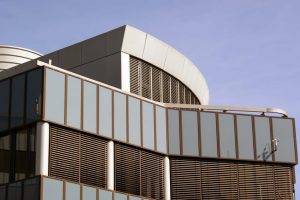Modern Buildings today will more often than not use aluminium for their windows, doors or facades and architects have the choice of either anodised or powder coated finishes.
What are the advantages and disadvantages between the two?
Historically, anodised finishes offered a range of silver, gold, black, blues and red tone metallic/anodised finishes that were not available in powder coat colours. However powder coating is today the better option powder coated finishes are available in the same sort of shades as anodised.
There are several advantages to powder coating over anodised finishes.
Cost.
Whilst anodising is sometimes cheaper than powder coating the cost really comes down to what standard of anodising and powder coating is being used. British Standards call for a 25mm micron fully sealed, anodised layer. However a cheaper anodising cost will not necessarily mean that it will have been coated to this 25micron minimum standard. The cost of anodising is very closely related to its thickness.
Powder Coated finishes can be specified with guarantee periods of more than 10 years. Ultimately with both anodised and powder coated finishes specified and coated correctly there will be a long term benefit whatever coating is used.
Weathering:
Aluminium as a construction material is weather resistant on its own. Aluminium left it its natural mill finish form will oxidise. What you may not know is that an anodised finish is also a form of oxidisation on the surface that is simply coloured to make it more attractive.
Both treatment methods offer weathering and durability. Powder coating covers the entire surface and prevents oxidisation .
Colour
Anodised finishes are normally only available in a matt finish although a wide variety of colour choices is available such as bronzes, blacks and silvers. Polished is also available.
Powder coating on the other hand is available in a massive range of colours with unlimited gloss levels from a simple matt, satin or gloss finishes to super matts to super gloss and textures.
Whilst today there are various finishes available that do match anodising, we should bear in mind that it will never be a pure match nor will it be viewed in the same shades when seen from different angles. Anodised finishes are consistent irrespective of the angle they are viewed from, powder coated finishes are not.
A consistent look.
Wood effects, marble effects and other types of textured finishes can also be produced with powder coating. Powder coating can also be applied to steel, certain plastics and certain woods. the advantage of powder coating is that whatever material it is applied to all the elements of the building will look the same.
Anodised finished can only be applied to aluminium which means other building elements coated in a similar colour that is not anodised will always look different.
A longer lifespan.
A significant advantage powder coating has over anodised finishes particularly on construction projects is that all powder coated finishes are expected to perform to a minimum lifespan over the life of the construction project.
In simple terms there are strict terms over how much colour in powder coatings is allowed to vary which means a powder coated finish at the start of the project will always look the same as another powder coated finish installed much later or towards the end of the project.
Anodised standards vary much more and these standards do not differentiate over the differences from batch to batch.
Easier repair and maintenance.
The wrong choice of coating can have detrimental effects on a building in the longer term. It is a given that window or door profiles will get damaged throughout the life of the building and anodising cannot be repaired like powder coating can.
Powder coated finishes can be repaired with a liquid coating that can accurately colour match and even dents and scuffs on aluminium profiles can be repaired and recoated.
Importantly as all elements powder coated in a building look the same, a consistent look can be maintained for years to come.
